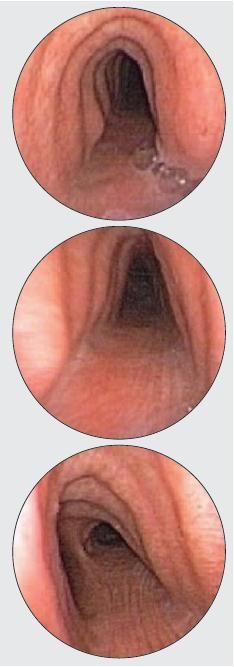A case of progressive shortness of breath in a patient with emphysema
A 71-year-old man who had received a diagnosis of emphysema 12 years ago was referred by his primary care physician to the pulmonary clinic. His symptoms were well controlled until a few months ago, when he complained of mild shortness of breath on physical activity. However, the shortness of breath worsened and became a significant limiting factor. He also had a persistent dry cough.
A 71-year-old man who had received a diagnosis of emphysema 12 years ago was referred by his primary care physician to the pulmonary clinic. His symptoms were well controlled until a few months ago, when he complained of mild shortness of breath on physical activity. However, the short

ness of breath worsened and became a significant limiting factor. He also had a persistent dry cough.
The results of the patient's recent cardiac workup were unremarkable. He was treated with a 2-week course of oral corticosteroids and antibiotics empirically just before this visit. These measures did not provide significant relief. His regular medications included inhaled tiotropium; aspirin, 81 mg/d; and atorvastatin, 20 mg/d.
On physical examination, the patient was afebrile and in no respiratory distress. There was no cyanosis or jugular venous distention nor were there palpable masses or lymphadenopathy in the neck. Lung sounds were vesicular but were somewhat diminished bilaterally. The patient's heart sounds and findings from an abdominal examination and examination of his extremities were unremarkable.
A radiograph of the chest was significant for hyperinflated lung fields but did not show any parenchymal abnormalities. Blood work revealed mild neutrophilic leukocytosis. Bronchoscopy was performed to rule out any upper airway obstruction (Figure). Examination of bronchoalveolar lavage fluid did not reveal any pathogens.
What is the likely diagnosis?
Answer on next page.
ANSWER:
This patient has significant tracheal narrowing in the coronal plane, also known as "saber sheath trachea." This is defined as a decrease in the internal coronal diameter of the trachea to half of or less than that of the corresponding sagittal diameter.
Discussion
Saber sheath trachea is a deformity in the intrathoracic trachea that is strongly associated with chronic obstructive pulmonary disease (COPD).1 The patency of the trachea and larger bronchi depends on the integrity of the cartilaginous support. The cartilage in the airway can be subjected to a variety of insults that can cause damage, weakening, and subsequent airway compromise. The deformity of the trachea is fixed and rigid, and the tracheal rings can be densely ossified.
In saber sheath trachea, the trachea collapses so that its coronal diameter becomes half of or less than that of the corresponding sagittal diameter. The extrathoracic trachea is normal in diameter, and the deformity is usually limited to the intrathoracic trachea. Other characteristics of saber sheath trachea are soft tissue thickening of the lateral walls and ossification of the cartilaginous rings. The distal bronchi maintain their usual nature and caliber.
Its presence on a chest radiograph is highly suggestive of COPD and may be the only radiographic finding in a patient with COPD. Sometimes the condition can also be detected by calculation of the tracheal index (the ratio of the coronal to the sagittal diameter, as measured 1 cm above the aortic arch). In patients with saber sheath trachea, the tracheal index is less than 0.66.
Our patient's clinical presentation is fairly typical of this condition. Most patients are asymptomatic, and in many cases, the diagnosis is made incidentally during bronchoscopy. Patients may remain asymptomatic; however, life-threatening airway compromise may develop rapidly.2 Saber sheath trachea has caused unexpected difficulty and negative-pressure pulmonary edema during endotracheal intubation for anesthesia and ventilation.3,4 If a patient with saber sheath trachea needs intubation, the air leak around the endotracheal tube may impede adequate ventilation.5
The saber sheath trachea is seen more commonly in men than in women.6 The pathogenesis of this condition is poorly understood. It is generally believed to be a sign of hyperinflation, although some have suggested that it is the result of cartilaginous remodeling of the trachea resulting from injuries caused by chronic coughing. Treatment is directed at the underlying condition (COPD).
References:
REFERENCES
1.
Greene R, Lechner GL. "Saber-sheath" trachea: a clinical and functional study of marked coronal narrowing of the intrathoracic trachea.
Radiology.
1975;115:265-268.
2.
Braman SS, Grillo HC, Mark EJ. A 44-year-old man with tracheal narrowing and respiratory stridor.
N Engl J Med.
1999; 341:1292-1299.
3.
Jacka MJ, Persaud SS. Negative-pressure pulmonary edema associated with saber sheath trachea.
Anesthesiology.
1999; 90:1209-1211.
4.
Garstang JS, Bailey DM. General anaesthesia in a patient with undiagnosed "saber-sheath" trachea.
Anaesth Intensive Care.
2001;29:417-420.
5.
Bayes J, Slater EM, Hedberg PS, Lawson D. Obstruction of a double-lumen endotracheal tube by a saber-sheath trachea.
Anesth Analg.
1994;79:186-188.
6.
Greene R. "Saber-sheath" trachea: relation to chronic obstructive pulmonary disease.
AJR.
1978;130:441-445.